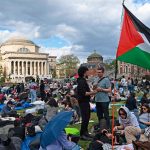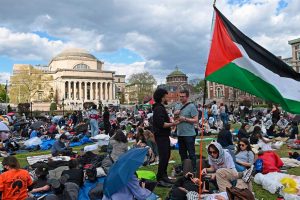
Washington, D.C., politicians are attempting to raise taxes on Uber and Lyft rides in the city’s downtown with the stated purpose of lessening traffic congestion. But the current design of the program offers basically no chance of improving downtown gridlock. It’ll just make some trips around town more expensive.
“Digital dispatch” companies would pay a $2 fee for every trip entering the downtown between 7 a.m. and 12 p.m. and leaving downtown between 12 p.m. and 7 p.m., according to a budget amendment suggested by Councilwoman Brianne Nadeau last week, DCist reported. Her ‘Congestion Management Program‘ is expected to raise $10.5 million a year, which would be used to subsidize fare-free bus lines.
“What we’ve seen is that post-pandemic vehicular traffic has come back and even surpassed the level that it was pre-pandemic, whereas ridership on transit has gone down,” Nadeau told DCist. “This measure is meant to help us restore some vibrancy to downtown D.C. by eliminating all of that gridlock and reducing the congestion, while also helping fund an incredibly important program.”
Properly designed, a congestion pricing program that charges motorists a fee to drive during peak hours or in gridlocked areas can indeed improve traffic flow. The policy is premised on the idea that roads fill up with traffic because they’re unpriced. It costs someone the same amount ($0) to drive during rush hour as it does at midnight. Since there’s more actual demand to drive during rush hour (hence the phrase), traffic piles up, and travel times increase.
This is unlike most other goods and services, where increased demand leads to increased prices, leading more marginal and price-sensitive consumers to moderate the quantities they purchase. This is why capitalist countries don’t have bread lines. The increased prices also serve as an incentive for suppliers to enter a market or increase their production. That’s why capitalist countries also have plenty of bread.
Congestion pricing reintroduces something akin to market pricing. When demand for driving goes up, so does the price of it, which discourages marginal drivers from getting on the road at particular times. Traffic flows improve.
Proponents argue this is superior to unpriced gridlock. People who place a high value on traveling at a particular time can do so. People who have less pressing errands are encouraged to wait until demand and prices are lower.
There are a couple of forms this policy can take. It can be applied to individual congested roads or even specific lanes on those roads. I-66 in the D.C. area already has congestion-priced lanes. There’s also cordon pricing, a form of congestion pricing, whereby drivers are charged a toll to enter the city center. New York is in the process of adopting a cordon pricing policy for lower Manhattan.
Ideally, these congestion charges should vary based on real-time traffic conditions so that tolls can be set at whatever ensures free-flowing traffic. That’s how the I-66 lanes work. It’s also how Singapore’s cordon pricing works. Dynamic tolls keep traffic flowing at a set speed.
Charging flat tolls at certain times, as Nadeau proposes, is a cruder and less effective method. But it at least tries to account for the demand for driving in particular areas at particular times—if it applies to everyone or almost everyone. But if the road remains unpriced for most motorists, they will likely respond to improved traffic flows by driving more.
This phenomenon is known as induced or latent demand. There are a lot of people who would travel during rush hour or to the city center if traffic conditions were slightly better. If a congestion fee on Ubers and Lyfts improves traffic conditions and roads remain unpriced, marginal drivers exempted from the congestion charges will just occupy the freed-up space.
The end result of D.C.’s policy as proposed is that the city’s congested downtown will see fewer rideshare trips and more private vehicle trips. That will be true even if people who would have taken rideshare rides take transit instead.
D.C. policy watchers on Twitter have argued that the real goal of the policy isn’t congestion reduction but revenue-gathering for free transit. (I’ve argued against fare-free transit here.)
It’s not being developed with the intent to reduce congestion, or with any data predicting it’s effect on congestion; it’s a charge meant to raise a certain amount of revenue. It may have an ancillary congestion benefit but that’s not the focus. (I am for it anyway)
— David Alpert (@alpert) May 2, 2023
If that’s the real goal here, then there’s no reason to concentrate the costs of that policy on rideshare companies and users of their services. Why not just increase the city’s sales tax? That, at least, would spread a more minimal cost to a broader number of people and businesses. However, it’s easier, politically, to tax rideshare companies. Uber and Lyft are “coercible” parties.
D.C. Mayor Muriel Bowser has called Nadeau’s proposal a terrible idea and an “attack on downtown.”
“I think it’s a terrible idea,” says Bowser on @BrianneKNadeau‘s proposal for a $2 congestion charge for rideshares going in and out of downtown D.C. “Any efforts to attack the downtown right now is a terrible idea.” https://t.co/9fpx8qVTvE
— Martin Austermuhle (@maustermuhle) April 27, 2023
That’s possible. A rideshare tax on downtown travel would likely mean fewer carless residents taking trips there to attend events, patronize businesses, and more. Owners of private vehicles taking advantage of lesser downtown traffic to pass through the area without actually stopping there aren’t as helpful for the area’s post-COVID economic recovery.
You could also argue private vehicle owners are going to be wealthier on average and, therefore, more likely to spend more money downtown if it were slightly easier to drive there.
The net effect on downtown from a rideshare “congestion” charge is hard to predict One thing we can say with near certainty is that this rideshare tax won’t improve congestion.



